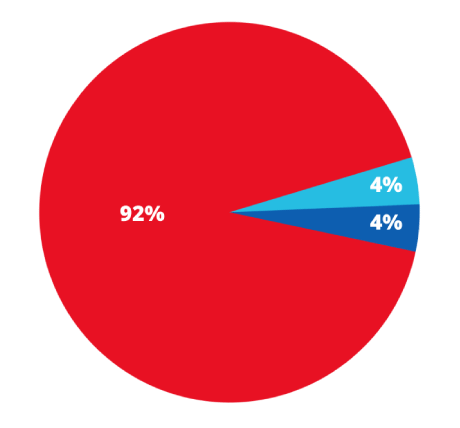Did you know that as much as 40 percent of the food supply in America goes to waste each year?
The U.S. Department of Agriculture estimates that more than 130 billion pounds of food is wasted in this country alone every year – an average of more than 200 pounds of food per person! It’s a staggering number, and combined with the approximately 17 percent of food going to waste in the rest of the world, it has real consequences for people everywhere:
- Wasted food goes into landfills instead of feeding hungry people. Tens of millions of people in America, and hundreds of millions of people around the world, do not have enough food to eat each year. But as we can see by the amount of food wasted, it’s not a supply problem. We have more than enough food for all people.
- But it’s not just the food that goes to waste. Producing food requires numerous resources: land, water, technology, labor, transportation, and much more. When we waste large quantities of food, we’re wasting all of those resources, too.
- Food waste also has a negative impact with regards to climate change. The production and supply chains for our food involve the release of some greenhouse gases, of course. And as the wasted food decomposes in landfills, it gives off methane, a greenhouse gas 86 times more powerful than carbon dioxide.
True, a large portion of wasted food is on the production and supply end. (Think about a refrigerator malfunction spoiling dairy products, or fruits and vegetables spoiling before they get to your grocery store.) But there are still many ways in which regular people can reduce food waste in measurable, impactful ways. So how can you do your part? Here are five simple tips:
1.Have a plan and buy what you need. Buying in bulk can be a money- and time-saver, reducing the amount of grocery store trips you’ll need to make. But it’s also often a good way to end up with wasted food. Developing a weekly meal plan, and only buying the ingredients you need to stick to it, is a good way of ensuring that all the food you buy will go to good use.
2.Don’t be afraid of “ugly” fruits and vegetables. One big source of food waste on the retail/consumer side is produce that may look visually unappealing – because of an odd shape, bruises, or other cosmetic reasons – but that are actually exactly as safe, nutritious and tasty as “normal-looking” fruit. Because of their appearance, “ugly” fruits and veggies are often dumped before they go bad. By buying “ugly” produce, you’ll get the same great taste and reduce waste.
3.Save your leftovers. Sometimes you just get full and can’t finish all the delicious food you cooked. Rather than dumping it, save it for another day! Store your leftovers in an airtight container and refrigerate or freeze as necessary. You’ve got a simple, easy-to-prepare meal for another time, or maybe an ingredient you can reuse for tomorrow’s dinner.
4.Donate what you can’t use. Local food banks are always in need of non-perishable food items (canned goods, dried fruits and vegetables, etc.). But your unspoiled perishable goods could also be acceptable, depending on the food bank and the quality of your food. Sharing your excess food with your community is doubly effective: less waste, and fewer people going hungry.
5.Compost your food waste. Sometimes food waste is just unavoidable. If you have fruits or vegetables that go bad (or used eggshells, nut shells, or coffee grounds), try composting them. Burying this organic material in your backyard provides nutrients to the soil, reduces your carbon footprint, and turns food waste into something much more productive. Just remember, you can’t compost meat, bones, fats and oils, or dairy products.
Help feed people in need with Embrace Relief
It’s important to be mindful of food waste, because so many millions of people in America and around the world don’t have the luxury to waste any food. Hunger can be found everywhere, and we all have a responsibility to reduce suffering where we can. At Embrace Relief, we’re doing our part by directly providing food to people in need.
During our International Hunger Relief Campaign: Ramadan 2021, Embrace Relief delivered food packages to more than 30,000 people across 12 countries, including more than 1,300 in Greece, more than 1,100 in Yemen, and hundreds more families in sub-Saharan Africa and South Asia. We also helped out locally, delivering food to 900 neighboring families in New Jersey.
For our International Hunger Relief Campaign 2022, we want to do so much more, and your support can make that possible. Donating any amount of money will make a difference – the amounts below represent the cost of one food package that will feed a family for one week:
- $50 for refugees in Greece
- $50 for families in the U.S.
- $65 for Yemeni families
- $25 for African children
So please, donate today. Every contribution you make helps one more family go to bed on a full stomach, and brings us one small step closer to ending world hunger.





















